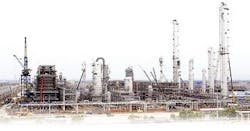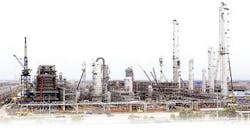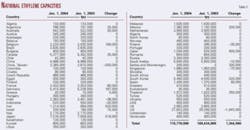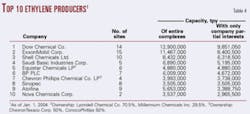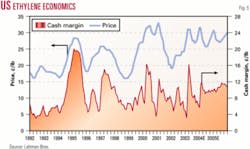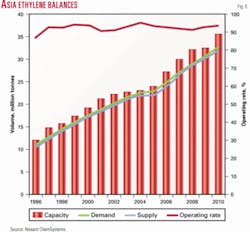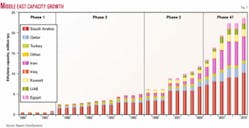null
Net global ethylene capacity additions recorded a nearly 2-decade low in 2003 due to significant shutdowns. Last year saw only 1.34 million tonnes/year (tpy) of net additions, compared with an increase of 2.4 million tpy in 2002, according to the latest ethylene survey.
Capacity as of Jan. 1, 2004, was 110.8 million tpy, an increase of less than 1% from a worldwide capacity of 109.4 million tpy as of Jan. 1, 2003.
About 1.8 million tpy of new capacity is listed in the latest survey, and roughly 1.7 million tpy of capacity was removed from the survey due to idled and shutdown plants. The remainder of additional capacity resulted from expansions at existing sites.
Fig. 1 shows that the net capacity addition in 2003 was the lowest level since 1986. This is a stark contrast to 2000 and 2001 when more than 6 million tpy were added in each of those years.
After dismal profitability in 2001-02 that was primarily due to overcapacity, the global ethylene markets started to recover last year. In 2003, US and global operating rates reversed the downtrend of the previous few years.
Fig. 2 shows that both North America and global operating rates were nearly 90% in 2003. Due to the lower than average amount of capacity coming online in 2003, operating rates will likely increase in 2004-05.
In North America, operating rates increased because operable capacity decreased due to idle and shutdown plants. In other areas of the world, additional demand due to improving economies surpassed capacity growth.
Fig. 3 shows that global ethylene demand increases will exceed capacity additions during the next few years. This should help ethylene producers maintain or increase margins.
Most future growth in ethylene capacity will happen outside North America, especially Asia and the Middle East, due to feedstock cost advantages.
New units
Two new ethylene units appear in this year's survey.
In 2003, National Petrochemical Co. started up its 520,000-tpy ethylene plant in Bandar Imam, Iran. The Amir Kabir plant is part of its petrochemical special economic zone olefins No. 6 project.
Qatar Chemical Co. Ltd. (Q-Chem) started up a 500,000-tpy ethylene plant in late 2002. Q-Chem, a joint venture of Qatar Petroleum (51%) and Chevron Phillips Chemical Co. LP (49%), inaugurated the plant in Mesaieed, Qatar, on Jan. 21, 2003. For that reason, it did not appear in last year's survey.
The Q-Chem venture is also building another cracker in Ras Laffan, Qatar, which should start up in 2007, according to the company.
OGJ has also received information on other plants that were inadvertently left out of previous surveys. These include Maruzen Petrochemical Co. Ltd.'s 480,000-tpy Chiba, Japan, ethylene plant, Thai Petrochemical Industry PLC's 350,000-tpy ethylene plant in Rayong, Thailand, and a 200,000-tpy plant in Pancevo, Serbia and Montenegro.
Regional review
Table 1 shows rankings of the 10 largest ethylene production complexes in the world; Nova Chemical Corp.'s Joffre plant retains the top spot on the list. The facilities in the list are the same as last year, but a few changed positions due to restated capacities.
Shell Chemicals Ltd.'s Norco, La., site moved down two spots because the company restated capacity as 1.5 million tpy, down from the 1.556 million tpy that appeared in last year's survey.
Table 2 ranks ethylene production capacity by region. The Middle East-Africa and Asia-Pacific regions each added just over 1 million tpy. Western Europe added more than 0.5 million tpy. Eastern Europe-FSU and South America had small increases.
North America was the only region that had a decline in capacity, mainly due to two Dow Chemical Co. plants on the US Gulf Coast that shut down.
On a percentage basis, the Middle East-Africa region had the most significant growth. The area increased ethylene capacity more than 10% and could see similar increases in future years.
Table 3 ranks ethylene production capacity by country. Iran and South Korea reflected the largest absolute increase in capacity with 520,000 tpy each. As previously mentioned, Iran started up a new cracker.
The additional capacity in South Korea is due to updated information from the country. In November 2001, Honam Petrochemical Corp. completed an expansion of its Yeosu ethylene plant. The 300,000-tpy expansion to 700,000 tpy total capacity appears in this year's survey.
Japan and Qatar also added more than 500,000 tpy of ethylene capacity, mainly due to new listings in the survey that were not shown in last year's report, as previously mentioned.
Significant expansions also occurred in Belgium, Germany, and Mexico.
In Belgium, Fina Antwerp Olefins (FAO), a joint venture between Atofina (65%) and ExxonMobil Corp. (35%), increased capacity in its three-train plant to 1.4 million tpy from 1.2 million tpy. Atofina, the chemical subsidiary of Total SA, reported that the expansion consisted of a new furnace and debottlenecking of the products recovery section.
In Germany, five different plants showed capacity increases, most of which occurred in the BP PLC plant in Dormagen.
BP reported to OGJ that the capacity had increased to 994,000 tpy from the 950,000 tpy listed in the 2002 survey.
Petróleos Mexicanos completed expansions at its Cangrejera and Morelos ethylene plants, increasing each to 600,000 tpy from 500,000 tpy.
Closed, idled plants
Table 3 also shows that a number of countries had declines in capacity. In many cases, this was due to plant shutdowns or idling of capacity.
The most significant changes occurred in the US, which lost more than 1.6 million tpy of ethylene production.
On Sept. 19, 2003, Dow announced that it had "safely completed the permanent shutdown of the Seadrift, Tex., olefins plant." The unit ceased operations on Sept. 12 and had an ethylene production capacity of 440,000 tpy.
On June 16, 2003, Dow had also shut down its Texas City, Tex., olefins plant that had an ethylene capacity of 660,000 tpy. Both plants were owned by Dow-subsidiary Union Carbide Corp.
The closures were part of Dow's US Gulf Coast ethylene review and were announced in late 2001.
The 385,000-tpy Equistar Chemicals LP plant in Lake Charles, La., was removed from the survey. The plant has reportedly been idle since early 2001, and the company does not plan to restart it until "market conditions recover."
Huntsman Chemical Corp.'s 136,000-tpy ethylene plant was also removed from the survey because it has reportedly been idled, again due to "sluggish market conditions." The unit was originally idled in June 2001.
Three small ethylene plants in India and Argentina were also closed.
Ownership, name changes
Atofina and Samsung General Chemicals Co. entered into a 50-50 joint venture in August 2003. Under the agreement, Atofina takes 50% ownership of the 630,000-tpy ethylene plant in Daesan, South Korea.
In December 2003, Petróleos de Venezuela SA announced that it plans to sell its 50% share in Ruhr Oel to Russia's Alfa Group Consortium, a privately owned financial conglomerate. Ruhr is a joint venture with PDVSA and BP, which owns and operates two ethylene plants in Gelsenkirchen and Munchsmunster, Germany.
Table 4 lists the top 10 owners of ethylene capacity worldwide.
Equistar, a joint venture of Lyondell Chemical Co. (70.5%) and Millennium Chemicals Inc. (29.5%) dropped one due to its idling of the Lake Charles, La., plant. Saudi Basic Industries Corp. (SABIC) moved past Equistar on the list.
Chevron Phillips moved up one spot due to the start-up of the previously mentioned Q-Chem plant.
Atofina is a newcomer to the list. Last year, the company was 12th in the world and moved up this year due to the expansion of the FAO facility and additional capacity acquired in the joint venture with Samsung.
Formosa Petrochemical Corp. dropped off the list.
Even though Dow shut down more than 1 million tpy, the company still has enough capacity to retain its hold on the largest worldwide producer of ethylene.
Construction
Last year, OGJ forecast that more than 8 million tpy of new capacity would come online in 2003, based on responses to construction surveys. Of this, only 1.8 million tpy actually started up. Similar to 2002, many companies delayed or cancelled projects due to oversupply or unfavorable project economics.
According to the latest OGJ construction data, 5.8 million tpy of new capacity will come on stream in 2004 (Click here to download a .pdf of Table 5).
The survey reports that two world-scale crackers will start up in 2004. One is Marun Petrochemical Co.'s 1.1-million-tpy unit in Bandar Imam, Iran. Marun is a subsidiary of National Petrochemical Co. and the new unit is part of the company's olefin No. 7 complex.
National Petrochemical is significantly expanding ethylene capacity in Iran. The company is planning to start up two more world-scale ethylene crackers, both at Bandar Assaluyeh, in 2005.
One unit is a 1.32-million-tpy cracker that will be owned by Jam Petrochemical Co. The other unit is a 1-million-tpy plant owned by Pars Petrochemical Co. Jam is 100% owned by National Petrochemical, and the ethylene portion of Pars is a 50-50 joint venture of National Petrochemical and Sasol Polymers.
If all these units start up as planned, Iran will increase its ethylene output to 4.6 million tpy from a current level of 1.2 million tpy, nearly a fourfold increase in 2 years.
National Petrochemical is also planning to start up a 500,000-tpy ethylene plant on Kharg Island, due on stream in 2005-06.
Other plants that are slated to start up in 2004 include:
- A 600,000-tpy plant in Nanjing, China, owned by BASF-YPC Co. Ltd., a 50-50 joint venture between BASF AG and Sinopec.
- A 500,000-tpy plant in Duque de Caxias, Brazil, owned by Rio Polimeros, a consortium of four companies that includes Uniao de Industrias Petroquimicas and Petroleo Brasileiro SA.
- A 450,000-tpy train built by SABIC at its plant site in Geleen, Netherlands.
In 2002, Dow announced that it would start up a new 900,000-tpy ethylene cracker in Seadrift, Tex. The cracker, which is slated for a 2007 start-up, will be constructed at the site of the 440,000-tpy plant that was shut down in September 2003.
Global market
Ethylene margins started a healthy recovery in 2003. Fig. 2 shows that worldwide and North American operating rates were both nearly 90% in 2003 as the amount of demand started catching up with capacity.
Fig. 3 shows that incremental demand will outpace the firm capacity starting up in the next 2 years. This means that operating rates should continue to increase until new plants are started up.
Even though 2003 profitability was still poor, the global petrochemical industry is past the bottom of the profit cycle, according to Don Bari, senior vice-president of Nexant ChemSystems.
The industry is poised for recovery and 2005 could be a strong period. In fact, global demand for ethylene will grow 4.8%/year and reach 140 million tonnes by 2010, according to John King, vice-president of Nexant ChemSystems.
North American market
In the US in 2003, ethylene consumption fell 2% to 51.2 billion lb, after a 7% rise in 2002, according to Nexant ChemSystems (Fig. 4).
Polyethylene is still the major consumer of ethylene in the US and worldwide. Polyolefin production decreased slightly in 2003, which caused the drop in ethylene consumption.
Growth in US ethylene consumption will likely closely follow domestic GDP growth.
High natural gas prices in the US have decreased producer competitiveness in key derivative export markets, according to Nexant ChemSystems.
This has led to a decrease in net trade of derivatives, and this trend will continue due to ethylene plant investments outside the US, especially in the Middle East.
The US will become a net importer of ethylene derivatives, probably in 2007-10. This will limit US ethylene consumption growth.
The US is now essentially balanced in ethylene with negligible exports. Nexant feels that domestic consumption growth will lead to higher production and sustained higher operating rates (Fig. 4).
The projected demand growth may be high enough that operators start up some idled plants.
In the short term, this demand will support higher ethylene margins (Fig. 5). The price of ethylene is also expected to maintain a level above 25¢/lb.
Other markets
Fig. 6 shows that the ethylene industry in Asia will continue to expand to keep pace with growing demand. Asia demand for ethylene is expected to grow at 7%/year and increase by 15 million tpy by 2010 from a current level of about 21 million tpy.
Asia is the fastest growing region in the global petrochemical industry. Despite the substantial capacity growth, the region will continue to import ethylene.
To keep pace with the strong global demand growth, the Middle East will add a significant amount of capacity. The region has been, and will continue to be, a large exporter of ethylene.
Fig. 7 shows the countries that will add ethylene production capacity.
